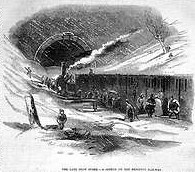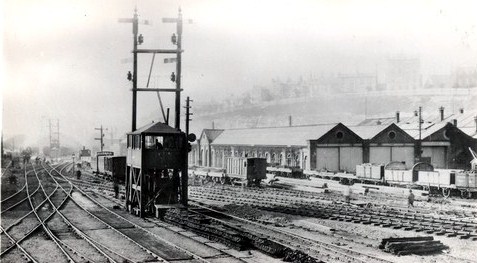
Railway accident on the
L.B.S.C.R.
Stoats Nest on 4th January 1847
THE GREAT SNOW STORM
12th January 1847

PHOTOGRAPHER UNKNOWN
The great snow storm on the evening of Tuesday 12th January 1847, the north eastern counties were visited by a tremendous snow storm for nearly 12 hours’ duration and the traffic on the London & Brighton Railway was stopped for much longer period. During the first few hours of the fall the up and down trains passed through the most with little difficulty, but after that time the line become wholly impossible, especially to this district, where the drifts from the hills into the cuttings were exceedingly great. It was the same with the old coach roads. Most of them blocked up, and the snow for miles around lies two to three feet in depth. So great has the fall been in the locality of the Balcombe parish that at 10.0 p.m. on Tuesday 27th January 1847, the station was found almost buried in snow. The first train from train from London in the evening that was stopped was the 5.0. p.m. express, containing a number of passengers, amongst who were Captain Hotham, Mr. Rowland Hill, and one
or two of the Directors of the London & Brighton Railway. On arriving from London, the fall of the snow became so thick as to prevent the engine driver scarcely seeing the length of the train, and shortly it was brought to a standstill. The engine driver, the stoker and the guards got down, and with shovels and implements proceeded to clear the snow off the rails to some
distance, thinking the great mass was confined to the cutting they were in. On the engine starting again it was brought to a dead stoppage at the end where the snow had been cleared. The men continued their labours as before, and vigour attempts were made to force the train, but were of trifling avail, as the wheels of the engine and the carriages were completely blocked with ice and snow.
There being no prospect of a passage being made through the snow as the snow was still falling heavily and had partly put out the fire, Mr Rowland Hill made known the unfortunate conditions of the train and passengers; and it being obvious that it so continued far sometime even it could be forward, the chilled passengers alighted from the carriages and returned to the station at Three Bridges, which, with a small inn adjacent is the only habitation for miles around. Here they remained the night, and in the morning returned to London. The exertions during the night to effect a passage that with the same result, one end of Balcombe tunnel being filled up with the drift. At an early hour four powerful engines arrived from town, accompanied by the company’s engineer, Mr. Hood, and these firmly coupled, started at a rapid pace in the hope of hope of cutting through the snow. This proved a failure, for the snow penetrated the fireboxes, the fires were extinguished and the engines rendered useless. As express was then forwarded back to London for the whole staff excavators the company’s employ. In due course of time a large army of “Navies” armed with spades and pick axes, and were immediately put to work. The company not having the benefit of the electric telegraph, and the old coach road, being like the line. Impossible for communications with Brighton and other parts down by the coast was consequently cut off. This continued until 4.0 p.m on Wednesday afternoon, last where the down line was sufficiently cleared to allow the passage of trains, but the up line still remained covered. Near to Brighton the railway is understood to have been in the same conditions, and that all trains on the previous night that left the metropolis were compel to return.

PHOTOGRAPHER UNKNOWN
BRIGHTON
On the 15th March 1847 the line from Chichester to Havant opened and on the 14th June, the line was extended onto Portsmouth. The section between Havant to Portsmouth was jointly owned with the London and South Western Railway. The line from Portsmouth Town (High Level) to Portsmouth Harbour was opened on the 2nd October 1876, where it become
Portsmouth Town 1847-1891
Portsmouth Town Locomotive shed was opened in c (14th June)1847 by the London Brighton and South Coast Railway in 1891 when it was relocated to nearby Fratton.
WEST CROYDON TO EPSOM LINE
West Croydon to Epsom opened on 10 May 1847. The line was original going to an extension of the New Cross to Croydon (West) Atmospheric Railway.
Railway accident on the
L.B.S.C.R.
Nutbourne on 31st May 1847
Brighton on 4th July 1847
New Cross on 12th July 1847
Haywards Heath 1847-1872
Haywards Heath Locomotive shed was opened on 1st October 1847 by the London, Brighton & South Coast Railway. The shed was located on the East side of Haywards Heath station.
The shed was a brick built two track straight dead-ended shed with a gable style slate roof and the facilities included a turntable, coal stage and a water tank. The shed closed in 1872 and converted for use as a goods shed.
PHOTOGRAPHER UNKNOWN
Jenny Lind Class
Brighton Engine men with Brighton
locomotive No. 65 Jenny Lind in c1847.
Railway accident on the
L.B.S.C.R.
SATURDAY 16th OCTOBER 1847
Accidents and offences
Collision at Keymer junction
Illustrated London news
A collision took place on Saturday last (11th October), between two passenger trains. Some exaggerated accounts of the injury done have appeared, and there is much confusion in them, but the accident seems to have been of a serious character.
It occurred soon after 9:00 o'clock, at the junction of the Keymer branch line, situate between Haywards Heath and Hassocks Gate stations, and about 9 miles from Brighton. The branch, it should be observed, has not been opened more than a week or two, and was constructed to avoid the circuitous route from Hastings, Lewes, et cetera, by the old line via Brighton.
The trains that met with the disaster were, the first down or parliamentary train, and the morning express train from Hastings, the former leaving London Bridge terminus at 7:00 AM and the latter Hastings at 20 minutes past seven. At the junction the company have placed signals, and the instructions were exceedingly explicit as two trains passing from the branch onto the mainline. Both trains were due at this point near the same time, and the custom is to signal the down parliamentary train to wait until the express has passed over.
It appears, in this instance, that when the "parliamentary" approached the junction, the signal was given that all was clear, and to go on, and it did so at the usual speed. On nearing the points, however, the engine driver perceived the express coming up, and the driver of the express engine also laboured under the same impression as to the signal indicating all clear. And they saw their dangerous position, the steam was instantly shut off, and those on the parliamentary train engine, perceiving collision must inevitably ensue, saved their lives by jumping off. Unfortunately, neither of the trains could be stopped in time to prevent the lamentable consequences; and at the moment of the express crossing the junction, it was cut into by the engine of the parliamentary down train.
The chief injuries were sustained by Mr Wyon, the medallionist to the Royal Mint, and Mr Driver, the land and estate agent of Parliamentary Street.
A gentleman named Lane, a passenger, writes to the Times as follows:-
"The collision was of a most frightful and terrific nature. I was thrown violently against a lady who sat opposite, and who for a few minutes believed that she had met her death. In addition to the general convulsion occasioned by such a shock, my left knee is seriously injured, and altogether disabled, though no fracture has taken place.
After a few minutes the numbness which ensued enabled me to go from the carriage with difficulty and seek a surgeon for Mr. Wyon; I was informed that one had been sent for to set a broken or dislocated arm, and that he would wait on Mr Wyon. While passing several carriages in advance of ours, I saw such evidence of other injuries as is furnished by marks of blood on the steps, and was told that many of the passengers were injured, but no one killed. I saw the demolished horsebox, and the shattered buffer board of the engine, and the broken tender.
When the surgeon examined the injury sustained by Mr Wyon he directed his removal to a farmhouse in the neighbourhood, to which he certainly did walk with the assistance of the medical gentleman and Mr Wyon junior who also suffered from the concussion, and from a similar, though less severe cut to that which his father received.
For some time Mr Wyon was unable to swallow, in consequence, I suppose, of internal bleeding, and his state excited the greatest alarm. Of the eight passengers in that carriage, only one appeared free from bruises; and, although their hurts may not prove serious, who shall say to what extent the violent concussion may entail permanent future evils?
In my own case, I found the knee on Saturday night quite disabled, and during two nights and the whole of Sunday suffered severely from pain, from neurologic symptoms, and from the shock which pervades the whole system. The engineers saved their lives by leaping from the engines".
Newhaven Harbour (N) 1847-1887
Newhaven’s first Locomotive Shed was opened on 8th December 1847 by the London, Brighton & South Coast Railway. This locomotive shed was located at Newhaven Harbour on the East side of the Harbour station. The shed was a brick built two track straight dead-ended shed with a 35 ft turntable. The shed was closed in 1887 with the opening of the new shed at Newhaven Town.
PHOTOGRAPHER UNKNOWN
Sharps Single